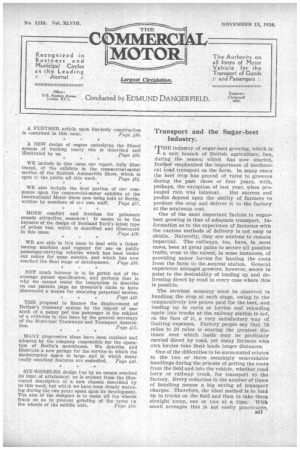Transport and the Sugar-beet Industry.
Page 1

Page 2

If you've noticed an error in this article please click here to report it so we can fix it.
THE industry of sugar:beet growing, which is -L a new branch of British agriculture; has, during the season which has now started, further emphasized the importance of mechanical road transport on the farm. In many eases the beet crop. has proved of value to growers during the past' three or four years, with, perhaps, the exception of last year, when pro longed rain was inimical. But suCcess and profits depend upon the • ability of farmers to produce the crop and deliver it to the factory at the minimum cost.
One of the most important factors in sugarbeet growing is that otadequate transport. Information as to the experience of factories with the various methods of delivery is not easy to obtain. Naturally, they are anxious to remain Impartial. The railways, too, have, in most cases, been at great pains to secure all possible traffic, even to the extent, in some instances, of providing motor lorries for hauling the roots from the farm to the mearest station. General experience amongst growers, however, seems to point to the desirability of loading up and delivering direct by road in every case where this is possible.
The 'strictest economy must be observed in handling the crop at each stage, owing to the comparatively low prices paid for the beet, and loading 'up in carts or lorries and reloading again into trucks at the railway station is not, on the face of it, a very satisfactory way of limiting expenses. Factory people say that 18 miles to .20 miles is nearing the greatest distance over which loads may be profitably carried direct by road, yet many farmers who own lorries take their loads longer distances.
One of the difficulties to be surmounted relates to the two or three seemingly unavoidable handlings during the process of getting the roots from the iield.and into the vehicle, whether road lorry or railway truck, for transport to the factory. Every reduction in the number of times of handling means a big saving of transport charges. Therefore, the ideal method is to load up in trucks on the field and then to take them straight away, one or two at a time. With small acreages this is not easily practicable,
but on larger farms it is, and the alternative seems to be some form of co-operation, whereby contractors may take charge of delivery.
In several of _ the important beet-growinc, centres firms have specialized in this work ad, it must be confessed, quite successfully. The steam tractor is found useful and is largely employed with two trailers. One firm hauled its beet regularly last year by such means all the way from Northampton to the factory at Hidderminster. It is possible, too, with the internal-combustion tractor suitably equipped for hauling off the land, to convey a load up to 15 tons or 16 tons along the road to the factory.
Anything that the motor, in its different forms, can do to simplify the transportation of sugar beet will be a real service to the agricultural industry. Owing to difficulties concerned with transport many farmers, not situated very near to a factory (thus enabling deliveries to be profitably made by road) have had to relinquish growing, a fact which seems to indicate that the growers of the root, in future, realize more and more that nearnessto the faaories is the solution of the transport problem.
Servicing Coaches Under Guarantee.
THE evolution of the fast long-distance coach has brought in its train a number of problems, some of which are difficult to solve, and of these one of the most interesting, and of the greatest importance both to manufacturers and users, is the question of what constitutes a fair guarantee: In the old days of motor coaching the vehicles seldom ran an average mileage of more than 12,000 a year. Now, in certain cases, 120,000 miles a year has been achieved by particular coaches. This means that it is possible to con
centrate what would, formerly, have been 10 years' work into one. These are, of course, extreme instances, but it is quite possible for many of these coaches to average something over 75,000 miles, which is the equivalent of six years' previous running. Suggestions have been made that manufacturers should give a year's free service with each vehicle sold, but with mileages such as these to consider this proposition is palpably absurd. Many guarantees are for 20,000 miles or six months, but as this mileage may easily be covered in a little over two months it means going to the other extreme.
Guarantees are always limited, but it is often difficult to convince users as to what are the justifiable limits and what constitutes unduly rapid wear or faults in construction which would come within the limits. In the ordinary way a user might consider that the cylinders of his vehicle were cast in very poor material if they required reboring or relining after one year's work, but with the long-distance coach the need for such a repair after this period of usage would not be at all surprising ; similarly, there is the wear on crankshaft% and bearings which, considering the time factor only, might -be regarded as excessive. • • We are of the opinion that only mileage should now figure as the factor to consider, but We would welcome Opinions on this matterfrom both users and makers, as we are convinced that it is a question which requires a thorough investigation, which would certainly -he to the ultimate benefit of both parties. 1 It must always be remembered that makers are not philanthropists and cannot be expected" to act in this capacity. Unfair calls upon a generous service may easily swallow a large percentage of potential profit.










































